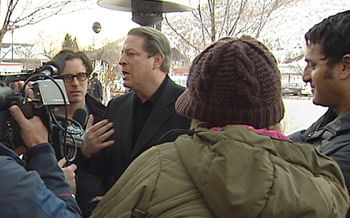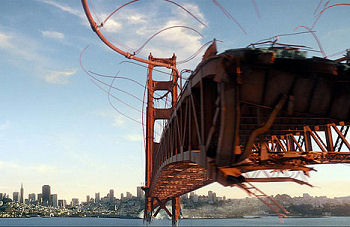I’ve read and heard about several possible dramatic features about Jimi Henrix over the years, and they’ve all been shot down over rights issues, which is a euphemism for the fact that Experience Hendrix, the company run by Hendrix’s sister Janie Hendrix, are very conservative-minded and very nickle-and-dimey in their thinking. The latest no-go is a biopic of some sort that Dragonslayer Films’ John Hillman wanted to make. He thought he’d secured likeness rights to Hendrix, along with music and live footage, but nope. Nobody is going to make a Jimi Hendrix feature as long as those Seattle small-timers have anything to do with the rights….never.
Here’s a good, concise, and yet very thorough piece by Hollywood Reporter columnist Anne Thompson about the selling of Al Gore, Laurie David, Lawrence Bender and David Guggenheim‘s An Inconvenient Truth.

Davis Guggenhiem (left, horn-rimmed glasses) and Al Gore plugging An Inconvenient Truth at last January’s Sundance Film Festival. (mpRm publicist Michael Lawson stands at far right)
I mentioned this earlier, but it would obviously be more synergistic if the Paramount Classics website had a strongly visual, easy-to-spot link to An Inconvenient Truth‘s home page, which is the same www.climatecrisis.net site that has been there all along (and which is plugged in the film).
You’d never know it by looking at the boring-blah photos for X-Men: The Last Stand on Rotten Tomatoes, but something kinda bad…well, “bad” is a relative term, so let’s say “bad” in an engineering sense…happens to the Golden Gate bridge in this film.

Here‘s a promotional video about David Fincher and his Zodiac editor Angus Wall using Apple’s Final Cut Pro…a good piece. The Paramount release (11.10) was shot with HD Viper cameras (i.e., the same used for Michael Mann‘s Collateral and Miami Vice). Nothing mu8ch about the film, although it shows stills of costar Brian Cox wearing his long, silvery Melvin Belli wig. It also shows that Fincher’s team have created complex digital cityscapes to portray San Francisco at it was in the late ’60s, when the Zodiac killings were (mostly) happening.
“I went to see Mission: Impossible III at one of the sneaks last night (i.e., Thursday, 5.4). I enjoyed it very much, and think it’s the best of the three films. And yet last night there were maybe 20 other people in the theatre besides my party of five. The theatre I went to see it in is a 10-plex that is opening the film today on five of their screens. They were apparently prepared to show the film on all five screens at 10 pm to accomodate crowds, but the need didn’t materialize. I think it√ɬ¢√¢‚Äö¬¨√¢‚Äû¬¢s gonna do well this weekend (I mean, with a 4,000 screen opening, no one will have much of a choice), but I wonder how strong it will be in the long run.” — David Adams, Boston, MA.
Mission: Impossible III “is almost a video nerd’s spoof of a whole genre of loud, cold, exhaustingly extreme thrill-ride films , Cruisified into extravagant pulp,” writes the San Diego Union-Tribune‘s David Elliott. That’s a pretty vivid sentence, but this one is even better: “[It’s] about as much fun as somebody dipping into your brain with a motorized ice cream scooper.”

“I have to echo what you and others had said about Cruise being damaged goods, especially when my girlfriend declared ‘no interest whatsoever in seeing another Tom Cruise movie,’ including ones where things explode and the early word is strong. Do you think it’s a gender thing? Are guys more forgiving of a star’s very public ‘private’ life as long as they deliver the goods on screen, while women can’t shake the fact that the guy they’re supposed to be cheering for on screen is something of a nutter in real life?” — Brad Abraham
MSNBC’s Eric Lundegaard is calling Mission: Impossible III a “fun movie, the best of the series,” in part because “it gets rid of that awful, floppy Hong Kong hipster haircut Ethan Hunt sported in the [John Woo] film.” If you read his article, you should know in advance that a fairly significant M:I:3 plot spoiler is contained within.

And yet Lundergaard has written it and it’s out there…whaddaya gonna do? Kids in Mumbai and Fairbanks and Panama City are mulling it over as we speak. SPOILER ALERT: What is Lundergaard’s Big Spill? A traitor-mole is a significant plot element in all three IM films, and going back to the same well over and over is a problem. “Which is why I√ɬ¢√¢‚Äö¬¨√¢‚Äû¬¢m urging Congress to look into IMF,” Lundegaard concludes. “Call a bi-partisan commission. Get Richard Ben-Veniste on the line. Three movies and three traitors is enough.”
“It would be a stretch to say that Tom Cruise needs a hit..what this guy needs is an intervention,” writes N.Y. Times critic Manohla Dargis in her review of Mission: impossible III. “[He needs] someone who can help the star once known as Tom Terrific return to the glory days, when the only things most of us really knew about him came from the boilerplate continually recycled in glossy magazines, sealing him in a bubble of blandness and mystery. In those days, we didn’t know that inside the world’s biggest movie draw lurked a reckless couch-jumper and heartless amateur pharmacologist . [You] have to wonder if the real mission in his newest film isn’t the search for the damsel in distress or the hunt for the supervillain, but the resurrection of a screen attraction who has, of late, seemed a bit of a freak. The domestication of Ethan Hunt may have seemed like a good idea, a humanizing touch, perhaps, but it only bogs down the action. Worse, it turns a perfectly good franchise into a seriously strange vanity project, as the simpering brunette is swept into a new world by a dashing operative for a clandestine organization. Much like the man playing him, [M:I:3‘s Ethan Hunt works only if you don’t know anything about what makes him tick. Once upon a Hollywood time, the studios carefully protected their stars from the press and the public. Now the impossible mission, it seems, is protecting them from themselves.”
Brandimensions, a firm that tries to eyeball movie sentiments of the 25 to 49 year-old demo by examining internet commentary and chat rooms, is saying that the early summer’s big four — X-Men 3: The Last Stand , Mission: Impossible III, The Da Vinci Code and Poseidon — are benefitting from good buzz and are will almost certainly be gretted with vigorous ticket sales. This is…oh, I’d say somewhere between 50% and 75% accurate prediction, but why quibble over fractions? If NRG tracking is wrong and Wolfgang Petersen’s Posedion makes out despite all the dire predctions, fine. I’ll be glad to see it happen.
The decision to screen Ron Howard‘s The DaVinci Code at the Cannes Film Festival’s Debussy theatre at 8:30 pm on Tuesday, 5.16 — the night before the festival’s de facto launch on Wednesday morning — is, one presumes, in line with Columbia’s decision to simultaneously screen it to the world’s film critics at more or less the same time. This means…what? That Opie’s Dae will screen for New York critics in the mid-afternoon of Tuesday the 16th, and for L.A. critics sometime in the late morning of the same day?

